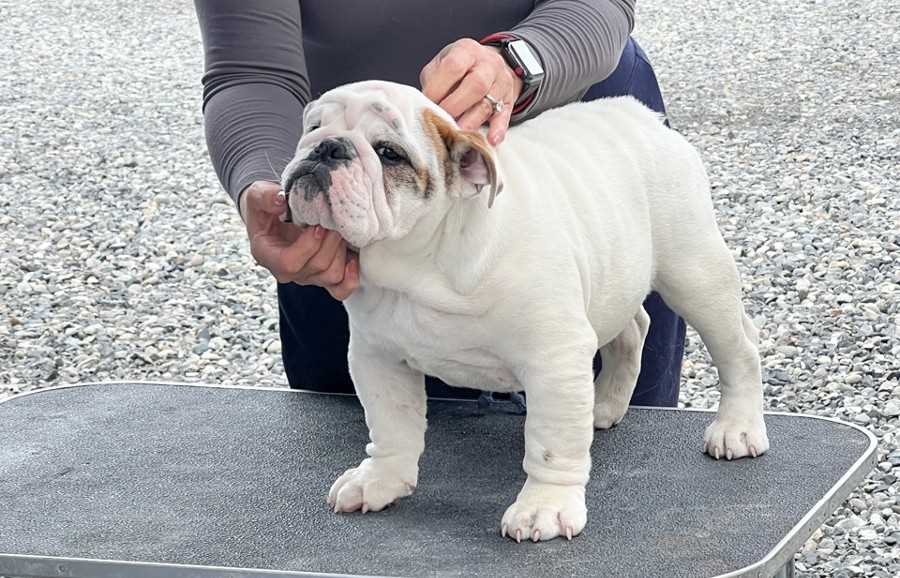
If you are a dog lover looking for a unique and adorable breed to bring into your home, look no further than the Blue and White Bulldog. With their striking blue and white coat, these dogs are sure to turn heads wherever they go. But there is more to these dogs than just their beautiful appearance.
The Blue and White Bulldog is known for its friendly and affectionate nature. They are incredibly loyal and make excellent companions for individuals and families alike. Despite their muscular build, these dogs are gentle and patient, making them great with children and other pets.
One of the most distinctive features of the Blue and White Bulldog is their blue and white coat, which is a result of a rare genetic mutation. This unique coloration sets them apart from other bulldog breeds and makes them even more special. Their short, smooth coat is easy to maintain and requires minimal grooming.
While the Blue and White Bulldog may have a tough exterior, they are actually quite sensitive and require a loving and nurturing environment. They thrive on attention and affection from their owners and can become easily stressed if left alone for long periods of time. Regular exercise and mental stimulation are also important for keeping these dogs happy and healthy.
If you are considering adding a Blue and White Bulldog to your family, be prepared for a lifetime of love and companionship. These dogs are sure to bring joy and laughter into your home with their playful and friendly nature. So why wait? Start your journey with a Blue and White Bulldog today!
About Blue and White Bulldogs
Blue and White Bulldogs are a unique and beautiful breed of dog that has gained popularity among dog lovers. They are known for their striking blue and white coat, which sets them apart from other bulldog breeds.
Blue and White Bulldogs are a medium-sized breed with a muscular build and a strong, sturdy frame. They have a broad head, a short muzzle, and expressive eyes that give them a friendly and approachable appearance.
One of the most distinctive features of Blue and White Bulldogs is their coat color. The blue and white pattern is created by a combination of genes that result in a blue coat with white markings. This unique coloration is what makes them stand out from other bulldog breeds.
The history and origin of Blue and White Bulldogs can be traced back to the English Bulldogs, which were bred for bull-baiting in the early 19th century. Over time, breeders started selecting for specific traits, including the blue and white coat color, resulting in the development of this distinct breed.
Blue and White Bulldogs are known for their friendly and gentle temperament. They are loyal and affectionate towards their owners and are great with children and other pets. They are also intelligent and eager to please, which makes them easy to train.
Training and exercise are important for Blue and White Bulldogs to keep them mentally and physically stimulated. They require regular exercise to maintain a healthy weight and prevent obesity. Training should be positive and reward-based, as they respond well to praise and treats.
Like all dog breeds, Blue and White Bulldogs are prone to certain health issues. Some common health problems include hip dysplasia, respiratory issues, and skin allergies. Regular veterinary check-ups and a balanced diet can help prevent and manage these health concerns.
Grooming and care for Blue and White Bulldogs are relatively easy. They have a short, smooth coat that requires minimal brushing. Regular bathing and nail trimming are also necessary to keep them clean and healthy.
Feeding and nutrition play a crucial role in the overall health and well-being of Blue and White Bulldogs. A balanced diet that is appropriate for their age, size, and activity level is important. It is recommended to consult with a veterinarian to determine the best diet for your dog.
If you are considering adding a Blue and White Bulldog to your family, it is important to research and find a reputable breeder. Adoption is also a great option, as there are often rescue organizations that specialize in bulldog breeds.
Physical Features of Blue and White Bulldogs
The Blue and White Bulldog is a distinctive breed known for its unique physical features. These dogs have a sturdy and muscular build, with a compact and low-to-the-ground body. They have a wide chest and strong shoulders, giving them a powerful appearance.
One of the most prominent features of the Blue and White Bulldog is its large, wrinkled face. They have a short, broad muzzle with a pronounced underbite. Their expressive eyes are round and set low on their face, giving them a friendly and alert expression. The ears of the Blue and White Bulldog can be either rose-shaped or button-shaped, adding to their distinctive look.
The coat of the Blue and White Bulldog is short, smooth, and glossy. The most common color for this breed is a blue-gray coat with white markings on the chest, face, and paws. The blue color can range from a light gray to a deep blue, giving each dog a unique appearance.
Blue and White Bulldogs have a strong and muscular neck, which leads to a broad and powerful body. They have a deep chest and a well-defined waistline. Their hindquarters are well-developed, giving them the strength and agility needed for various physical activities.
These dogs have a distinctive gait, with a rolling motion that is characteristic of the breed. They have a confident and determined stride, which adds to their overall presence and charm.
Overall, the Blue and White Bulldog is a breed that stands out for its unique physical features. From their muscular build to their wrinkled face and expressive eyes, these dogs are truly a sight to behold.
History and Origin of Blue and White Bulldogs
The history and origin of Blue and White Bulldogs can be traced back to England in the 18th century. These dogs were originally bred for bull-baiting, a popular sport during that time. The breed was developed by crossing the Old English Bulldog with various terriers to create a dog that was strong, agile, and tenacious.
During the early 19th century, the breed’s popularity grew rapidly, especially among the working class in England. They were commonly used as guard dogs and were also seen in the show ring. Blue and White Bulldogs were exported to other countries, including the United States, where they gained popularity as well.
Over the years, the breed underwent significant changes in its physical appearance. The original Blue and White Bulldogs had a more athletic build, with longer legs and a less pronounced facial structure. However, breeders started selecting for a more compact body, shorter legs, and a distinctive pushed-in nose, which are the defining features of the modern English Bulldog.
Today, Blue and White Bulldogs are recognized as a distinct breed and are loved for their unique appearance and gentle temperament. They are no longer used for bull-baiting or as working dogs but are cherished as loyal companions and family pets.
| Key Points |
|---|
| – Blue and White Bulldogs originated in England in the 18th century. |
| – They were initially bred for bull-baiting. |
| – The breed’s purpose shifted to being a companion dog after bull-baiting was banned. |
| – Blue and White Bulldogs gained popularity in England and were exported to other countries. |
| – The breed underwent changes in its physical appearance over the years. |
| – Modern Blue and White Bulldogs are known for their unique appearance and gentle temperament. |
Temperament of Blue and White Bulldogs
The temperament of blue and white bulldogs is often described as friendly, gentle, and affectionate. These dogs are known for their calm and patient nature, making them great companions for families and individuals alike.
Blue and white bulldogs are generally good with children and other pets, although proper socialization is important to ensure positive interactions. They are known to be protective of their loved ones and will often act as a watchdog, alerting their owners to any potential danger.
Despite their somewhat intimidating appearance, blue and white bulldogs are not typically aggressive. They are generally easygoing and adaptable, making them suitable for various living situations, including apartments and houses with yards.
While they may not be the most energetic breed, blue and white bulldogs still require regular exercise to maintain a healthy weight and prevent boredom. Daily walks and playtime are usually sufficient to meet their exercise needs.
Training blue and white bulldogs can be a bit challenging due to their independent nature, but with patience and positive reinforcement techniques, they can be trained to be well-behaved and obedient. Early socialization and consistent training are essential to ensure a well-rounded and well-behaved dog.
Blue and white bulldogs are generally known for their loyalty and devotion to their owners. They thrive on human companionship and enjoy being part of the family. They are often described as “clowns” due to their playful and entertaining nature.
It’s important to note that individual temperaments can vary, even within the same breed. It’s always a good idea to spend time with a blue and white bulldog before bringing one into your home to ensure that their temperament aligns with your lifestyle and expectations.
Training and Exercise for Blue and White Bulldogs
Training and exercise are crucial for the health and well-being of Blue and White Bulldogs. These dogs are known for their intelligence and strong-willed nature, so it is important to start training them from a young age. Consistency and positive reinforcement are key to successful training.
Basic Obedience Training

Blue and White Bulldogs should be trained in basic obedience commands such as sit, stay, come, and heel. It is important to use positive reinforcement techniques, such as treats and praise, to motivate and reward the dog for good behavior. Training sessions should be short and frequent to keep the dog engaged and focused.
Socialization
Blue and White Bulldogs need to be properly socialized to ensure they are comfortable and well-behaved around other dogs and people. Exposing them to different environments, sounds, and experiences from a young age will help them become confident and well-adjusted adults. Taking them to puppy classes or arranging playdates with other well-behaved dogs can also be beneficial.
| Exercise Needs | Frequency | Duration |
|---|---|---|
| Walks | At least once a day | 30 minutes to 1 hour |
| Playtime | Several times a day | 15-30 minutes each session |
| Mental Stimulation | Daily | 10-15 minutes |
Exercise Routine
Blue and White Bulldogs require regular exercise to keep them physically and mentally stimulated. Daily walks are essential to meet their exercise needs. These dogs also enjoy playing fetch, tug-of-war, and other interactive games. Mental stimulation, such as puzzle toys or obedience training sessions, should also be included in their daily routine.
It is important to note that Blue and White Bulldogs are prone to overheating due to their short snouts. Therefore, exercise should be done during cooler times of the day and in shaded areas. It is also important to provide them with plenty of water to stay hydrated.
Health Issues in Blue and White Bulldogs
Blue and White Bulldogs are generally healthy dogs, but like all breeds, they are prone to certain health issues. It is important for potential owners to be aware of these issues and take necessary precautions to ensure the well-being of their pets.
One of the most common health issues in Blue and White Bulldogs is respiratory problems. Their short snouts and compact airways make them susceptible to breathing difficulties, especially in hot and humid weather. It is important to provide them with a cool and well-ventilated environment and avoid strenuous exercise during extreme temperatures.
Another health concern in Blue and White Bulldogs is skin problems. Their wrinkled skin and folds can easily trap moisture and bacteria, leading to infections and irritations. Regular cleaning and drying of their skin folds are essential to prevent these issues. Additionally, keeping their coat clean and well-groomed can help in preventing skin-related problems.
Blue and White Bulldogs are also prone to joint and bone disorders, such as hip dysplasia and patellar luxation. These conditions can cause pain and mobility issues in dogs. Regular exercise, a balanced diet, and maintaining a healthy weight can help in reducing the risk of these disorders. It is also advisable to provide them with orthopedic beds and avoid excessive jumping or rough play.
Eye problems are another concern in Blue and White Bulldogs. They are prone to conditions like cherry eye, dry eye, and corneal ulcers. Regular eye examinations by a veterinarian and proper eye care can help in detecting and managing these issues at an early stage.
Lastly, Blue and White Bulldogs may also be susceptible to allergies and food sensitivities. It is important to provide them with a high-quality diet that is suitable for their specific needs. Regular veterinary check-ups can help in identifying any allergies or sensitivities and making necessary dietary adjustments.
Grooming and Care for Blue and White Bulldogs

Grooming and care are essential aspects of keeping your Blue and White Bulldog healthy and happy. These dogs have a short, smooth coat that requires minimal grooming, but there are still some important tasks to keep in mind.
Brushing
Although Blue and White Bulldogs have short hair, regular brushing is still necessary to remove loose fur and keep their coat in good condition. Use a soft-bristle brush or a rubber grooming mitt to gently brush your dog’s coat. This will help distribute natural oils and prevent matting.
Bathing
Blue and White Bulldogs do not require frequent bathing unless they get particularly dirty. Over-bathing can strip their coat of essential oils and lead to dry skin. Use a gentle dog shampoo and make sure to thoroughly rinse your dog’s coat to avoid any residue.
Nail Care
Regular nail trims are important for Blue and White Bulldogs to prevent overgrowth and discomfort. Use a dog nail clipper or grinder to carefully trim the nails, being cautious not to cut too close to the quick. If you are unsure, consult a professional groomer or veterinarian for assistance.
Ear Cleaning
Blue and White Bulldogs are prone to ear infections, so regular ear cleaning is crucial. Use a veterinarian-recommended ear cleaner and a cotton ball or pad to gently wipe the inside of your dog’s ears. Avoid inserting anything into the ear canal and consult a vet if you notice any signs of infection.
Dental Care

Proper dental care is essential for Blue and White Bulldogs to prevent dental issues such as gum disease and tooth decay. Brush your dog’s teeth regularly using a dog-specific toothbrush and toothpaste. You can also provide dental chews or toys to help keep their teeth clean.
Skin Care
Blue and White Bulldogs are prone to skin allergies and irritations, so it’s important to keep their skin healthy. Regularly check for any signs of redness, dryness, or irritation. If you notice any issues, consult a veterinarian for proper diagnosis and treatment.
In addition to grooming, providing proper care for your Blue and White Bulldog includes regular exercise, a balanced diet, and routine veterinary check-ups. By taking these steps, you can ensure that your beloved pet remains healthy and happy for years to come.
Feeding and Nutrition for Blue and White Bulldogs
Feeding and nutrition play a crucial role in the overall health and well-being of blue and white bulldogs. These dogs have specific dietary needs that should be met to ensure they stay healthy and maintain an ideal weight.
Dietary Requirements
Blue and white bulldogs require a balanced diet that consists of high-quality protein, healthy fats, and carbohydrates. Protein is essential for muscle development and repair, while fats provide energy and support the health of the skin and coat. Carbohydrates are a source of energy and should come from whole grains and vegetables.
It is important to choose a dog food that is specifically formulated for bulldogs. These foods often have a higher protein content and contain ingredients that support joint health, as bulldogs are prone to hip and joint issues.
Feeding Schedule
Blue and white bulldogs should be fed two meals a day to prevent overeating and obesity. It is recommended to divide their daily food portion into two equal meals and feed them at the same time each day. Avoid leaving food out all day as bulldogs tend to overeat, which can lead to weight gain and other health problems.
Portion Control
Portion control is essential to prevent obesity in blue and white bulldogs. The amount of food they need depends on their age, size, activity level, and metabolism. It is best to consult with a veterinarian to determine the appropriate portion size for your bulldog. Overfeeding can lead to weight gain, while underfeeding can result in nutritional deficiencies.
It is important to monitor your bulldog’s weight and body condition regularly. If you notice your dog gaining or losing weight, adjust their portion size accordingly.
Water Intake
Blue and white bulldogs should have access to fresh water at all times. Proper hydration is essential for their overall health and helps prevent urinary tract issues. Make sure to clean and refill their water bowl daily.
Treats and Supplements
Treats should be given in moderation and should not exceed 10% of your bulldog’s daily caloric intake. Choose healthy, low-calorie treats that are specifically made for dogs. Avoid giving them table scraps or foods that are toxic to dogs, such as chocolate, onions, and grapes.
Supplements are not usually necessary if your bulldog is eating a balanced diet. However, if your veterinarian recommends any supplements, follow their instructions carefully.
Overall, providing a balanced diet, portion control, and proper hydration are key to ensuring the health and well-being of blue and white bulldogs. Consult with a veterinarian for specific dietary recommendations based on your dog’s individual needs.
Availability and Adoption of Blue and White Bulldogs
Blue and White Bulldogs are a popular breed among dog lovers, known for their unique coloration and charming personality. If you are interested in adding a Blue and White Bulldog to your family, there are several options available for adoption.
1. Breeders
One way to find a Blue and White Bulldog is through reputable breeders. These breeders specialize in breeding and raising Bulldogs with specific color patterns. It’s important to do thorough research and choose a breeder who prioritizes the health and well-being of their dogs. Make sure to visit the breeder’s facility, ask questions about their breeding practices, and meet the parent dogs to assess their temperament.
2. Rescue Organizations
Another option is to adopt a Blue and White Bulldog from a rescue organization. Many Bulldogs end up in shelters or rescue groups due to various reasons, such as their owners being unable to care for them anymore. Rescue organizations provide a second chance for these dogs, ensuring they find loving and responsible homes. Contact local rescue groups or search online for Blue and White Bulldogs available for adoption.
When adopting from a rescue organization, you may need to go through an application process and meet certain criteria. This is to ensure that the dog is placed in a suitable home where their needs will be met. Adoption fees may also apply, which typically cover the cost of vaccinations, spaying/neutering, and other necessary medical treatments.
3. Online Platforms

There are various online platforms and websites dedicated to pet adoption, where you can find Blue and White Bulldogs available for adoption. These platforms allow you to search for dogs based on location, breed, and other preferences. You can browse through listings, view photos, and read descriptions to find the perfect match for your family.
When adopting a dog online, it’s important to exercise caution and verify the legitimacy of the source. Look for reputable websites that have a screening process for their listings and prioritize the well-being of the animals. Always ask for additional information and request to meet the dog in person before making a final decision.
4. Local Bulldog Clubs
Local Bulldog clubs or associations can also be a valuable resource for finding a Blue and White Bulldog. These clubs often have members who are breed enthusiasts and may have connections to breeders or know of Bulldogs in need of a new home. Participating in club events and activities can help you network with other Bulldog lovers and potentially find the perfect companion for your family.
Remember, adopting a Blue and White Bulldog is a lifelong commitment. Take the time to research and consider your options, and choose a dog that fits well with your lifestyle and family dynamics. By adopting, you not only provide a loving home for a dog in need but also experience the joy and companionship that Bulldogs bring to their families.

Tyler Newsom, a canine enthusiast, is passionate about bulldogs and their coat care. With years of experience and dedication, he shares his expertise to help bulldog owners maintain their beloved pets’ fur health and vitality through practical tips and advice.
